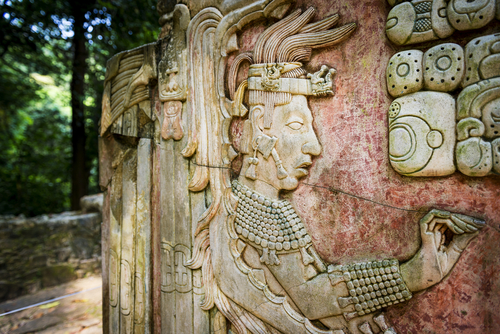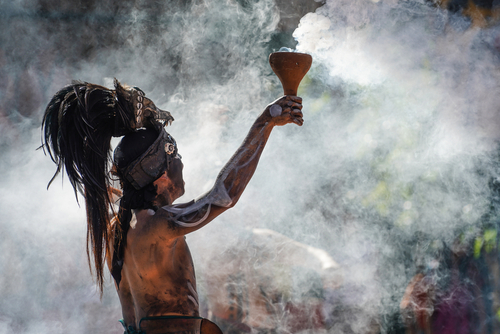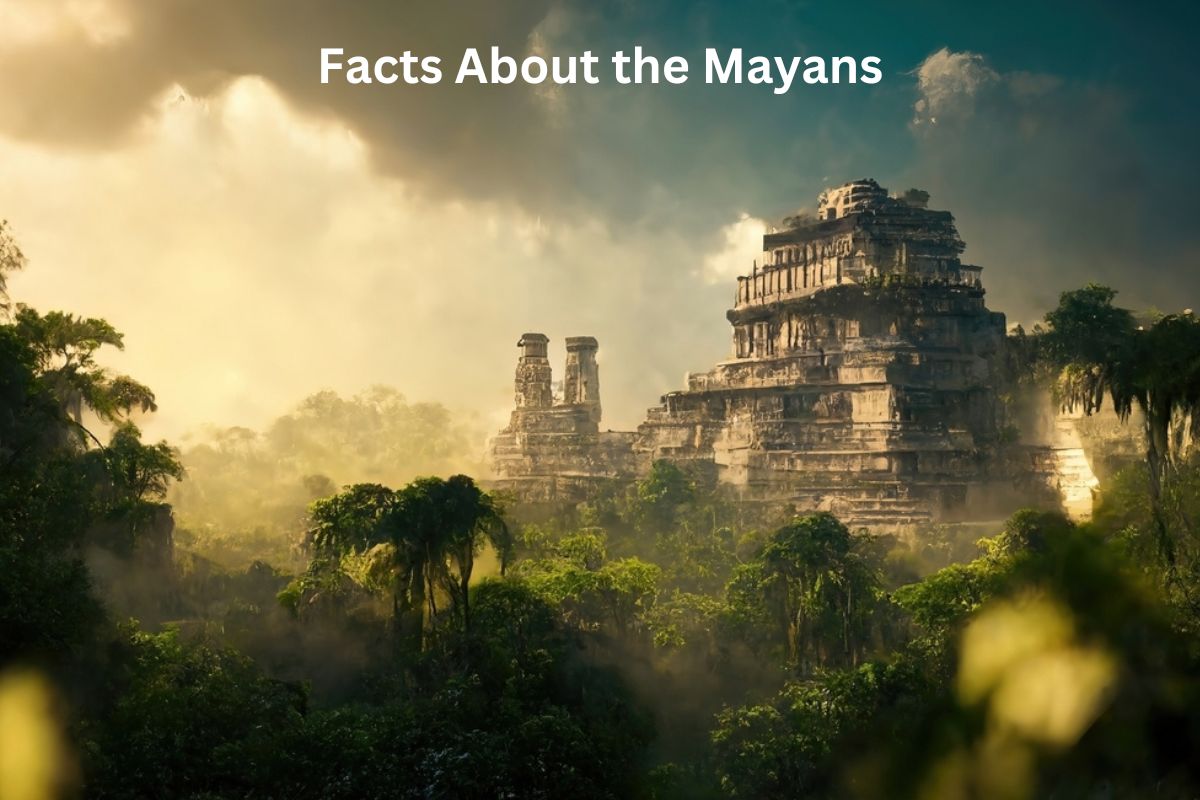The Maya civilization, one of the most remarkable ancient societies in the Americas, flourished in the lush landscapes of modern-day Mexico, Guatemala, Belize, Honduras, and El Salvador.
Emerging around 2000 BCE and reaching its peak between 250 CE and 900 CE, the Maya left a profound legacy of achievements in various fields.
From their awe-inspiring architecture and intricate hieroglyphic writing to their advanced calendars and profound understanding of mathematics and astronomy, the Maya made significant contributions to human history.
Their polytheistic religious beliefs and innovative agricultural techniques also played integral roles in shaping their culture and daily lives.
While the civilization eventually declined around 900 CE, modern Maya communities continue to cherish and preserve their rich cultural heritage to this day.
Mayans Facts
1. Flourished between 2000 BCE and 900 CE
The Mayan civilization emerged in the Preclassic period, around 2000 BCE, in the lowland regions of present-day southern Mexico and Central America.
The civilization’s development can be divided into three main periods: the Preclassic (2000 BCE – 250 CE), the Classic (250 CE – 900 CE), and the Postclassic (900 CE – 1500 CE).
Also Read: Facts About Tenochtitlan
During the Classic period, the Maya experienced their peak in population, urbanization, cultural achievements, and political organization. It was a time of tremendous growth, with the construction of large cities and monumental architecture.

2. City-states ruled by independent elites
The Maya civilization was not a centralized empire but rather a collection of city-states, each with its own ruling elite and government structure. City-states were urban centers surrounded by a rural hinterland.
Also Read: Accomplishments of the Mayans
They often engaged in trade, alliances, and occasional conflicts with each other. Rulers in Mayan city-states were considered divine figures, acting as intermediaries between the people and the gods.
These rulers and the nobility controlled the political, religious, and economic aspects of their respective city-states.
3. Impressive architecture and urban planning
Mayan cities were characterized by their impressive architecture and well-planned urban layouts. The cities were designed with ceremonial centers, plazas, ball courts, and residential areas.
The most prominent structures were pyramids, temples, and palaces, which often served religious, administrative, and ceremonial purposes.
Some of the most well-known Mayan cities, such as Tikal, Chichen Itza, Palenque, and Copán, showcased remarkable architectural feats, with intricate carvings and sculptures decorating their buildings.
The construction of these grand structures required sophisticated engineering and labor coordination, highlighting the organizational skills and engineering knowledge of the Maya civilization.
4. Developed a complex hieroglyphic writing system
The Maya civilization is renowned for its development of a complex writing system that used hieroglyphs. The Maya script is one of the few fully developed writing systems of the pre-Columbian Americas.
It is a combination of logograms and syllabic symbols, representing both complete words and syllables. The writing system was primarily recorded on stone monuments, stelae, and murals, but it was also used on pottery, codices (books made of bark paper), and other artifacts.
The Maya hieroglyphs were deciphered by modern scholars in the latter half of the 20th century, thanks in part to the discovery of the Rosetta Stone of the Maya, the “Dresden Codex.” This breakthrough has provided valuable insights into the history, religion, astronomy, and daily life of the Maya civilization.

5. Created advanced calendars for tracking time
The Maya were skilled astronomers and mathematicians who developed several calendars to track time with precision. The most well-known of these calendars is the Long Count calendar.
It was based on a system of cycles and provided a way to record historical events over long periods. The Long Count calendar began on August 11, 3114 BCE, and the Maya used it to represent dates far into the future.
In addition to the Long Count calendar, the Maya had a 260-day ritual calendar known as the Tzolk’in and a 365-day solar calendar called the Haab’. The combination of the Tzolk’in and Haab’ resulted in a 52-year “Calendar Round,” which was essential for organizing religious ceremonies and agricultural activities.
The Maya’s advanced understanding of astronomy allowed them to accurately predict celestial events such as eclipses, equinoxes, and solstices, which were crucial for agricultural planning and religious observances.
6. Made significant contributions to mathematics and astronomy
The Maya were highly skilled mathematicians, and their numerical system was based on a vigesimal (base-20) counting system.
They used three symbols to represent numbers: a dot for one, a horizontal bar for five, and a conch shell glyph for zero. This concept of zero was revolutionary and predated its use in other civilizations.
Mayan mathematicians made significant advances in areas such as arithmetic, algebra, and geometry. They could perform complex calculations and use mathematics in architectural and astronomical contexts.
Their knowledge of astronomy allowed them to develop accurate calendars, make observations of celestial bodies, and create precise predictions of astronomical events.
Through their sophisticated understanding of mathematics and astronomy, the Maya achieved remarkable cultural achievements and established a deeper connection with the cosmos, which played a fundamental role in their religious beliefs and practices.
7. Skilled farmers with innovative agricultural techniques
The Maya civilization was highly dependent on agriculture, and the majority of the population were farmers.
They practiced a form of slash-and-burn agriculture, where they cleared land by cutting down and burning trees and vegetation. This process enriched the soil and allowed for successful cultivation of crops.
The primary crop cultivated by the Maya was maize (corn), which held significant cultural and religious importance. Alongside maize, they also grew beans, squash, chili peppers, avocados, and other fruits and vegetables.
To maximize productivity, the Maya employed innovative farming techniques. They built terraces into hillsides to create flat surfaces for cultivation, which helped prevent soil erosion. Additionally, the Maya constructed raised fields known as chinampas in swampy areas.
These fields were built up with layers of mud, vegetation, and other organic matter, creating fertile and productive agricultural plots.
8. Had a polytheistic religious belief system
Religion played a central and influential role in Mayan society. The Maya were polytheistic, meaning they worshipped multiple gods and goddesses. Their pantheon was extensive, and each city-state had its own set of patron deities. These gods represented various aspects of nature, celestial bodies, and human activities.
Mayan religious rituals and ceremonies were conducted by priests, who acted as intermediaries between the people and the gods. Ceremonies were performed to appease the gods, seek their blessings, and ensure the well-being of the community.
Human sacrifice was a significant aspect of Mayan religious practices, particularly during major ceremonies or events. Sacrifices were believed to please the gods and maintain the cosmic balance.
9. Civilization declined around 900 CE
The Classic period of the Maya civilization, characterized by great achievements and prosperity, came to an end around 900 CE.
During this time, many major cities in the southern lowlands were abandoned or experienced a significant decline in population and political power. The reasons for the decline are complex and still debated among historians and archaeologists.
Some proposed factors contributing to the decline include environmental issues, such as deforestation and soil degradation, which could have led to food shortages and resource depletion.
Additionally, intercity warfare and conflict might have weakened the region’s social and political structures. There is also evidence of prolonged drought during this period, which could have further strained resources and exacerbated existing problems.
However, it is important to note that some Maya cities in the northern Yucatan continued to thrive even after the Classic period.
10. Modern Maya communities preserve cultural heritage
Despite the decline of the ancient Maya civilization, the Mayan people and their descendants continue to thrive in the present day. Throughout the centuries, the Maya have faced challenges, including colonization and attempts to suppress their cultural practices and language. However, many Maya communities have persevered, preserving their rich cultural heritage.
Today, modern Maya communities can be found in Mexico, Guatemala, Belize, Honduras, and El Salvador. They maintain traditional customs, crafts, art, and languages, which often vary among different Maya groups. Maya languages, such as Yucatec Maya, K’iche’, and Mam, are still spoken and are considered part of the Mayan language family.
Furthermore, traditional ceremonies, rituals, and celebrations are still observed, keeping alive the ancient practices and beliefs of their ancestors. The modern Maya people take pride in their heritage and play an essential role in enriching the cultural diversity of the regions they inhabit.
